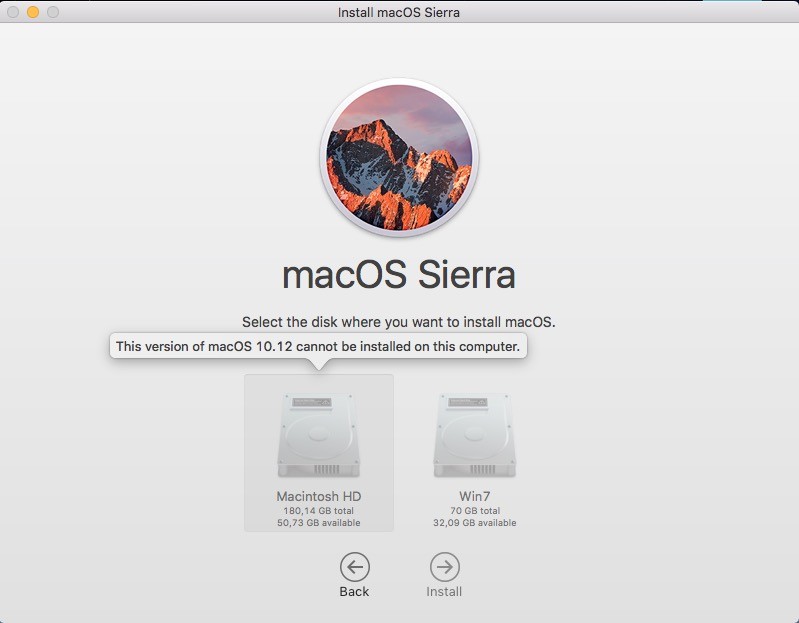MacOS Sierra :
Apple’s latest desktop operating system is macOS Sierra, All MacBook and iMac models prior to Late 2009 and all MacBook Air, MacBook Pro, Mac mini, and Mac Pro models prior to 2010 are not officially supported by macOS Sierra, but there is a way to install the new software on older, unsupported devices.
Supporting devices
Insert your desired USB drive, open Disk Utility, and format it as Mac OS Extended (Journaled). Open the 'macOS Sierra Patcher' tool, and browse for your copy of the macOS Sierra Installer App.Ensure that the tool successfully verifies the app. MacOS Catalina is the most innovative variant of the macOS that came within our palms October 7, 2019. The debut of Catalina occurred in WWDC 2019. How to Install macOS Catalina on Unsupported Mac. The older macOS High Sierra had a little more scope. Apple said that would run happily on a late 2009 or later MacBook or iMac, or a 2010 or later MacBook Air, MacBook Pro, Mac mini or Mac Pro.
- How To Get MacOS Sierra On “unsupported” Macs? I got a MacBook Pro Mid 2009 thats technically “unsupported” By Apple, its specs are 8GB DDR3 RAM With a.
- MacOS Sierra: Apple’s latest desktop operating system is macOS Sierra, All MacBook and iMac models prior to Late 2009 and all MacBook Air, MacBook Pro, Mac mini, and Mac Pro models prior to 2010 are not officially supported by macOS Sierra, but there is a way to install the new software on older, unsupported devices.
- Early-2008 (or newer) Mac Pro, iMac, or MacBook Pro
- Late-2009 (or newer) MacBook Air or unibody MacBook
- Early-2009 (or newer) Mac Mini or white MacBook
List of requirements:
- The installation file macOS Sierra Developer Preview.
- USB flash drive of at least 8GB.
- Tool macOS Sierra Patcher, available here.
How to install macOS on unsupported models :



Step 1: Connect the flash drive to the computer , open Disk utility and format the USB flash drive with format as Mac OS Extended.
Note : If you are formatting a whole disk or USB Also make sure you use GUID partition table.
Step 2: Run the utility “macOS Sierra Patcher” and in the program window, specify the copy you previously downloaded the installation file “macOS Sierra Developer Preview Installer”.
The program should confirm the successful validation of the image with the message “Successfully verified as “Install 10.12 Developer Preview”.
Step 3: In the program window select your USB drive in the list of Target Volume and click the button “Start Operation”.
Step 4: After run your Mac from a flash drive with macOS Sierra. To do this, after you restart the computer hold the Alt keyboard button.
Step 5: After running the installer, open Disk utility.
Step 6: Select the disk or partition you put the new OS and delete all the data on it, making sure the format is OS X Extended (journaled). If you format the entire disk, choose GUID.
Step 7: Continue with the normal installation of macOS Sierra.
Macos Sierra Unsupported Mac Os
Step 8: After installation is complete, restart your computer and boot into the installation USB again. At this time you need to open the application Post Install macOS.
High Sierra For Unsupported Mac
Step 9: In the software, select the model of your Mac. The tool will automatically propose the recommended settings depending on your computer. You can change them on your own.
Step 10: Select the Volume, select the drive on which you installed macOS Sierra and click Patch.
Step 11: once completed, press Reboot. Before rebooting may take several minutes required to rebuild the cache.
Step 12: Do a normal restart and Voila ! your Mac will run macOS Sierra.
Features
Macos Sierra Unsupported Mac
- macOS Sierra can automatically sync all files on your Desktop and in your Documents folder with other Macs running Sierra. You can also access these files in your iPhone or iPad using iCloud Drive.
- Apple Pay is now part of macOS, not just iOS.
- Optimized Storage can store infrequently used files in iCloud while keeping them immediately available any time you are online.